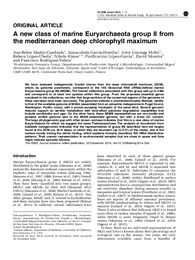Por favor, use este identificador para citar o enlazar este ítem:
https://hdl.handle.net/11000/4813Registro completo de metadatos
| Campo DC | Valor | Lengua/Idioma |
|---|---|---|
| dc.contributor.author | Martín Cuadrado, Ana Belén | - |
| dc.contributor.author | García Heredia, Inmaculada | - |
| dc.contributor.author | Gonzaga Moltó, Aitor | - |
| dc.contributor.author | López Úbeda, Rebeca | - |
| dc.contributor.author | Kimes, Nikole | - |
| dc.contributor.author | López García, Purificación | - |
| dc.contributor.author | Moreira, David | - |
| dc.contributor.author | Rodríguez Valera, Francisco | - |
| dc.contributor.other | Departamentos de la UMH::Producción Vegetal y Microbiología | es |
| dc.date.accessioned | 2018-09-04T10:46:29Z | - |
| dc.date.available | 2018-09-04T10:46:29Z | - |
| dc.date.created | 2014-12-23 | - |
| dc.date.issued | 2018-09-04 | - |
| dc.identifier.issn | 1751-7362 | - |
| dc.identifier.issn | 1751-7360 | - |
| dc.identifier.uri | http://hdl.handle.net/11000/4813 | - |
| dc.description.abstract | We have analyzed metagenomic fosmid clones from the deep chlorophyll maximum (DCM), which, by genomic parameters, correspond to the 16S ribosomal RNA (rRNA)-defined marine Euryarchaeota group IIB (MGIIB). The fosmid collections associated with this group add up to 4Mb and correspond to at least two species within this group. From the proposed essential genes contained in the collections, we infer that large sections of the conserved regions of the genomes of these microbes have been recovered. The genomes indicate a photoheterotrophic lifestyle, similar to that of the available genome of MGIIA (assembled from an estuarine metagenome in Puget Sound, Washington Pacific coast), with a proton-pumping rhodopsin of the same kind. Several genomic features support an aerobic metabolism with diversified substrate degradation capabilities that include xenobiotics and agar. On the other hand, these MGIIB representatives are non-motile and possess similar genome size to the MGIIA-assembled genome, but with a lower GC content. The large phylogenomic gap with other known archaea indicates that this is a new class of marine Euryarchaeota for which we suggest the name Thalassoarchaea. The analysis of recruitment from available metagenomes indicates that the representatives of group IIB described here are largely found at the DCM (ca. 50m deep), in which they are abundant (up to 0.5% of the reads), and at the surface mostly during the winter mixing, which explains formerly described 16S rRNA distribution patterns. Their uneven representation in environmental samples that are close in space and time might indicate sporadic blooms. | en |
| dc.description.sponsorship | This work was supported by projects MICROGEN (Programa CONSOLIDER-INGENIO 2010 CDS2009-00006) | en |
| dc.description.sponsorship | MEDIMAX BFPU2013-48007-P from the Spanish Ministerio de Economía y Competitividad | - |
| dc.description.sponsorship | The French Agence Nationale de la Recherche (ANR-08-GENM-024-001, EVOLDEEP) | - |
| dc.description.sponsorship | MaCuMBA Project 311975 of the European Commission FP7 (FEDER funds supported this project), ACOMP/2014/024 and AORG 2014/032. | - |
| dc.format | application/pdf | es |
| dc.format.extent | 16 | es |
| dc.language.iso | eng | es |
| dc.rights | info:eu-repo/semantics/openAccess | es |
| dc.subject.other | 579 - Microbiología | es |
| dc.title | A new class of marine Euryarchaeota group II from the mediterranean deep chlorophyll maximum | en |
| dc.type | info:eu-repo/semantics/article | en |
| dc.identifier.doi | 10.1038/ismej.2014.249 | - |
| dc.relation.publisherversion | https://doi.org/10.1038/ismej.2014.249 | - |

Ver/Abrir:
Martin-Cuadrado et al 2014 ISMEJ A new class of marine Euryarchaeota.pdf
3,86 MB
Adobe PDF
Compartir:
 La licencia se describe como: Atribución-NonComercial-NoDerivada 4.0 Internacional.
La licencia se describe como: Atribución-NonComercial-NoDerivada 4.0 Internacional.
.png)